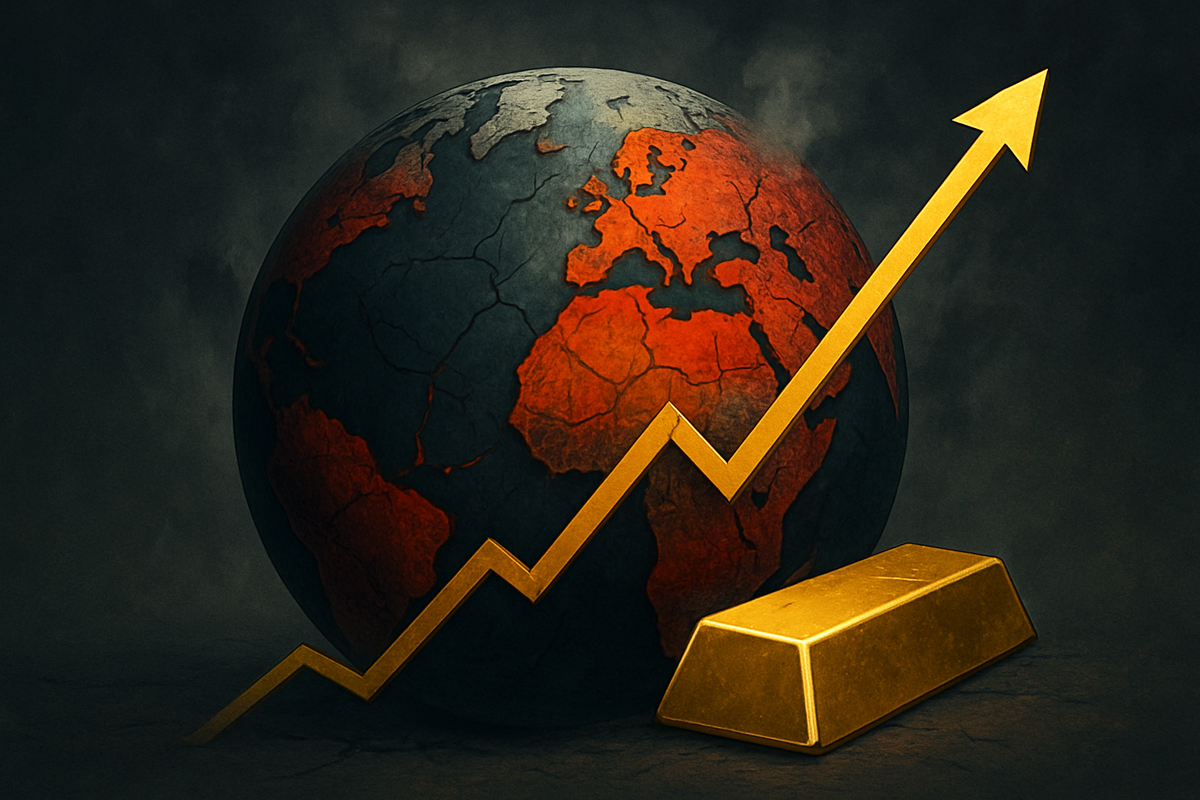
As the calendar turns towards late 2025, a narrative suggesting the conclusion of a significant "war cycle" from 2021-2025 has been circulating in some circles. This notion posits a potential shift towards global de-escalation and increased geopolitical stability. However, a closer examination of the prevailing expert consensus reveals a more complex and, in many ways, more turbulent reality. Far from witnessing a widespread winding down of conflicts, the global outlook for 2025, according to leading geopolitical analyses, points to persistent, and in several critical regions, escalating conflicts and instability. This challenging environment is poised to reinforce, rather than diminish, gold's traditional role as a safe-haven asset, likely sustaining or even increasing its price amidst continued uncertainty.
The immediate implications for global geopolitical stability, therefore, are largely contrary to the idea of a peaceful conclusion to a "war cycle." Instead, the world is bracing for continued tensions, elevated risks, and a proliferation of armed conflicts. This ongoing volatility underscores the enduring appeal of gold as a store of value, as investors seek refuge from the pervasive uncertainties shaping the international landscape. The market's initial reactions have largely reflected this sentiment, with gold prices demonstrating resilience and even upward momentum in response to global flashpoints, suggesting a collective acknowledgment that the era of geopolitical tranquility remains a distant prospect.
Persistent Global Turmoil: A Closer Look at the 2021-2025 Geopolitical Landscape
The period spanning 2021 to 2025 has been, and continues to be, characterized by a significant fracturing of the global order, marked by a rise in interstate and intrastate conflicts, rather than a coherent "war cycle" culminating in peace. While the idea of long-term cycles in international relations exists, the current trajectory does not align with a general de-escalation by 2025. Instead, analysts from institutions like the International Crisis Group, S&P Global, and the Council on Foreign Relations consistently highlight a world grappling with a myriad of deepening international crises.
Specific flashpoints dominating this period include the protracted and devastating Russia-Ukraine conflict, which has reshaped European security dynamics and continues to pose significant geopolitical risks. In the Middle East, the Israel-Hamas war, coupled with broader regional tensions involving Iran and Hezbollah, threatens wider escalation. East Asia faces ongoing civil strife in Myanmar, potential naval confrontations in the South China Sea, and persistent unease on the Korean Peninsula. Furthermore, intensifying civil wars and ethnic violence in Sudan and the Sahel region continue to fuel severe humanitarian crises and regional instability across Africa. These events collectively paint a picture of sustained global turbulence, with traditional deterrence mechanisms and diplomatic avenues increasingly strained.
The timeline of events leading to this moment is a continuous thread of escalating tensions rather than a build-up to a definitive end. From Russia's full-scale invasion of Ukraine in early 2022 to the resurgence of conflict in the Middle East in late 2023, and numerous other regional flare-ups, the global security environment has steadily deteriorated. Key players and stakeholders involved range from nation-states and their military alliances to non-state actors, international organizations, and multinational corporations, all navigating an increasingly unpredictable landscape. Initial market reactions have consistently seen a flight to safety during these periods of heightened tension, with gold often experiencing upward price movements as investors seek to de-risk their portfolios from equity and bond market volatility.
Navigating the Storm: Winners and Losers in a Volatile World
In an environment of persistent geopolitical instability rather than a concluding "war cycle," the landscape for public companies is sharply divided between those poised to benefit from increased defense spending and resource scarcity, and those vulnerable to supply chain disruptions, trade wars, and market uncertainty.
Potential Winners:
- Defense Contractors: Companies like Lockheed Martin (NYSE: LMT), Raytheon Technologies (NYSE: RTX), and Northrop Grumman (NYSE: NOC) are likely to see sustained demand for their products and services as nations globally increase defense budgets in response to perceived threats. The ongoing conflicts and the general rearmament trend across Europe and Asia provide a robust pipeline for orders.
- Gold Mining Companies: Firms such as Barrick Gold (NYSE: GOLD), Newmont (NYSE: NEM), and Agnico Eagle Mines (NYSE: AEM) stand to benefit directly from sustained or rising gold prices. As gold's safe-haven appeal strengthens amidst instability, demand for the precious metal increases, boosting the revenues and profitability of mining operations.
- Cybersecurity Firms: With geopolitical tensions often spilling over into the digital realm, companies specializing in cybersecurity, such as Palo Alto Networks (NASDAQ: PANW) and CrowdStrike (NASDAQ: CRWD), are in high demand. Governments and corporations alike are investing heavily to protect critical infrastructure and sensitive data from state-sponsored attacks and cyber warfare.
- Energy Companies (selectively): While global instability can disrupt energy markets, certain energy companies, particularly those involved in domestic production or with diversified supply chains, might see increased demand or benefit from higher commodity prices driven by supply concerns.
Potential Losers:
- Multinational Corporations with Complex Supply Chains: Companies heavily reliant on globalized supply chains, especially those traversing conflict zones or regions prone to trade disputes, face significant risks. Disruptions can lead to increased costs, production delays, and reduced profitability. Industries like automotive, electronics, and apparel are particularly vulnerable.
- Airlines and Tourism Operators: Geopolitical instability and conflicts often deter international travel, directly impacting airlines like Delta Air Lines (NYSE: DAL) and United Airlines (NASDAQ: UAL), as well as hospitality and tourism companies. Travel advisories and perceived risks can significantly reduce passenger volumes and bookings.
- Companies Dependent on Global Trade Agreements: A splintering world order and rising protectionism can undermine international trade agreements, negatively affecting companies that thrive on open markets and reduced tariffs. Exporters and companies with significant international sales may face new barriers and increased costs.
- Consumer Discretionary Companies: In times of economic uncertainty fueled by geopolitical tensions, consumer confidence often wanes, leading to reduced spending on non-essential goods and services. This can adversely affect retailers, luxury brands, and entertainment companies.
These dynamics highlight how a prolonged period of instability creates a stark differentiation in corporate performance, rewarding resilience, strategic positioning in essential sectors, and adaptability to evolving global risks.
Broader Significance: A New Era of Geopolitical Risk
The continuation of heightened geopolitical instability, rather than the conclusion of a "war cycle," signifies a profound shift in global dynamics, moving away from the post-Cold War era of relative unipolarity and towards a more multipolar, fragmented, and confrontational world. This event—or rather, the lack of a peaceful conclusion—fits into broader industry trends emphasizing resilience, localization, and strategic autonomy. Businesses are increasingly re-evaluating their global footprints, diversifying supply chains, and investing in risk mitigation strategies to insulate themselves from geopolitical shocks.
The ripple effects on competitors and partners are substantial. Companies in allied nations may find themselves drawn into new economic blocs, while those operating across geopolitical divides could face increased scrutiny, sanctions, or even forced divestment. This environment encourages "friend-shoring" and "near-shoring" as nations and companies prioritize security of supply over pure cost efficiency. Regulatory and policy implications are also significant, with governments worldwide enacting new export controls, investment restrictions, and cybersecurity mandates aimed at protecting national interests and critical infrastructure. The weaponization of economic policy, through sanctions and trade barriers, has become a more common tool in geopolitical competition.
Historically, periods of sustained global instability, such as the Cold War or the various regional conflicts throughout the 20th century, have consistently underscored gold's role as a safe haven. During these times, gold has often demonstrated a negative correlation with traditional financial assets, providing a hedge against market volatility, inflation, and currency debasement. Unlike past cycles that might have seen a clear victor or a definitive end to a major conflict, the current landscape is characterized by a "systemic shift in global conflict dynamics," where traditional deterrence and diplomacy are fraying. This lack of a clear resolution or a return to a stable equilibrium means that the historical precedents of gold's performance during uncertainty are highly relevant, suggesting continued strength for the precious metal.
What Comes Next: Navigating Persistent Turbulence
Looking ahead, the short-term and long-term possibilities are shaped by the enduring nature of global instability. In the short term, continued volatility in commodity markets, particularly energy and food, is highly probable as geopolitical tensions disrupt supply lines and influence production. Equity markets are likely to remain susceptible to sudden corrections triggered by new geopolitical flashpoints, while bond markets may see increased demand for sovereign debt from stable economies. Gold prices are expected to maintain their elevated levels, with potential for further spikes during periods of intense crisis.
Strategic pivots and adaptations will be crucial for both nations and corporations. Governments will likely continue to prioritize national security, defense spending, and the reshoring of critical industries. Corporations, in turn, must focus on building resilient supply chains, diversifying their geographic exposure, and investing in advanced risk intelligence. For investors, this environment necessitates a focus on diversification, with a strong allocation to traditional safe havens like gold, alongside investments in sectors that are resilient to, or benefit from, geopolitical risk, such as defense, cybersecurity, and essential infrastructure.
Potential scenarios and outcomes for this period include:
- Prolonged "Frozen Conflicts": Many current conflicts may not see definitive resolutions but rather settle into prolonged states of low-intensity conflict or uneasy ceasefires, maintaining a constant undercurrent of global risk.
- Increased Regional Power Blocs: The world could further fragment into distinct geopolitical and economic blocs, leading to increased competition and reduced multilateral cooperation.
- Technological Arms Race: The intersection of geopolitical competition and technological advancement will likely accelerate a technological arms race, particularly in AI, quantum computing, and advanced weaponry, creating both opportunities and threats for tech companies.
- Sustained Gold Demand: As long as these conditions persist, the fundamental drivers for gold's safe-haven appeal will remain strong, supporting its price and role as a critical portfolio diversifier.
A New Normal: Sustained Volatility and Gold's Enduring Value
The notion of a concluding "war cycle" in 2025, leading to widespread de-escalation, appears to be a misreading of current geopolitical trends. Instead, the global landscape is characterized by sustained, and in many instances, escalating conflicts, ushering in a new era of persistent turbulence and unpredictability. The key takeaway is that the world is not returning to a period of calm but is rather adapting to a "new normal" where geopolitical risk is a constant and pervasive factor.
Moving forward, markets will continue to be highly sensitive to geopolitical developments. Investors should anticipate ongoing volatility and the potential for rapid shifts in sentiment. The assessment of the market moving forward suggests a continued emphasis on resilience, strategic asset allocation, and an understanding of the interconnectedness of geopolitical events and financial outcomes.
Final thoughts on the significance and lasting impact point to a fundamental re-evaluation of global economic and political structures. The era of seamless globalization is giving way to one prioritizing security, national interest, and regional alliances. What investors should watch for in the coming months includes the evolution of major conflicts (Russia-Ukraine, Israel-Hamas), the trajectory of U.S.-China relations, the stability of key energy-producing regions, and the ongoing actions of central banks regarding gold reserves. In this environment, gold's historical role as a hedge against uncertainty is not merely preserved but amplified, making it an indispensable component of a well-diversified portfolio.
This content is intended for informational purposes only and is not financial advice





